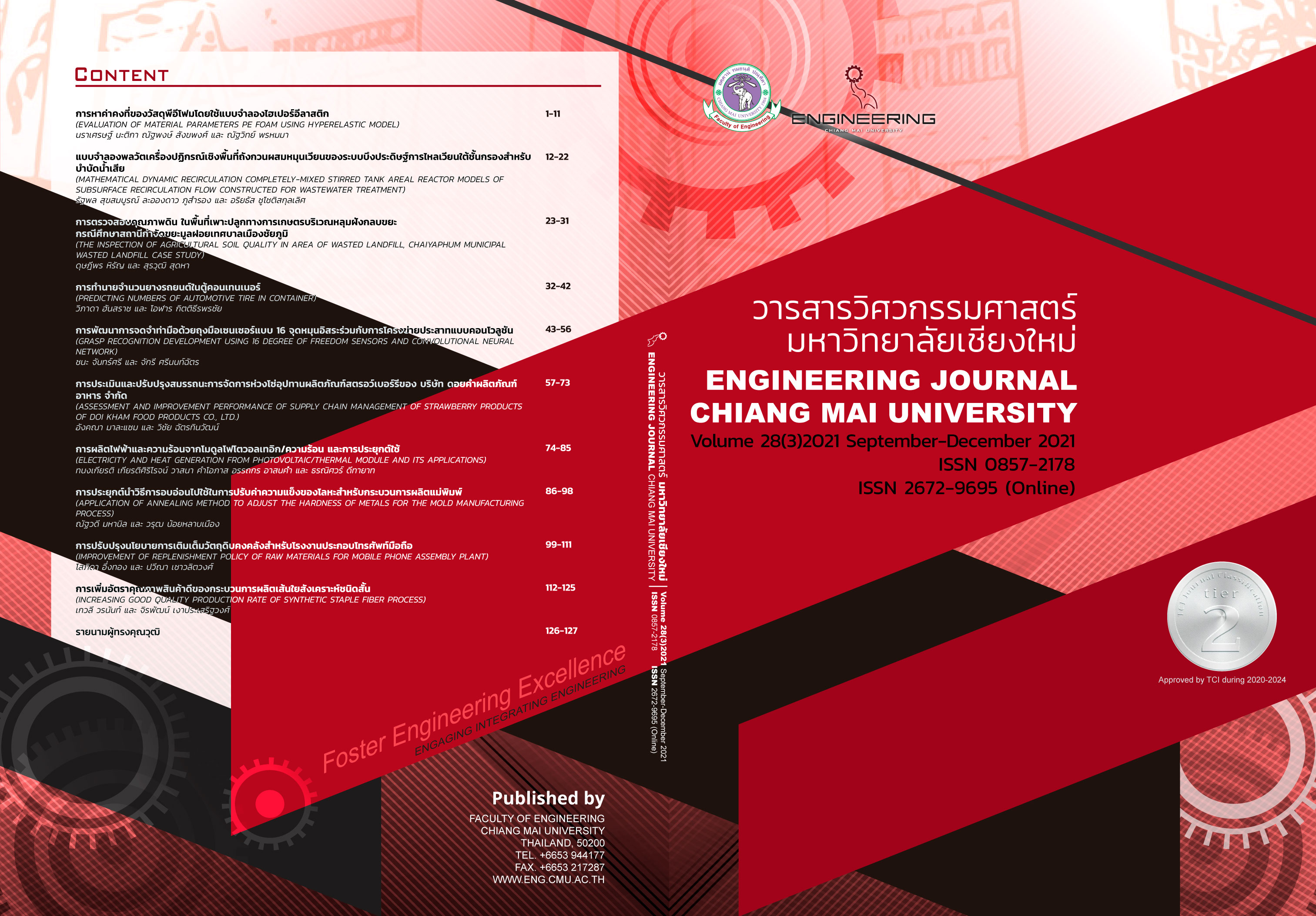Evaluation of Material Parameters PE Foam Using Hyperelastic Model
Keywords:
polyethylene foam, large deformation, hyperelastic model, curve fitting, Blatz-Ko modelAbstract
This paper deals with the determination of parameters of polyethylene foam using Curve Fitting Method. This method is useful for calculating parameters from Stress-Strain relation obtained from uniaxial compressive test in case of large deformation. Polyethylene foam is selected as specimens with 20-millimeter minimum thickness and contacted area is more than 2500 square millimeter. ASTM D3574 type C is chosen to be testing standard. Since Polyethylene foam is assumed to be hyperelastic material, large deformation theory with strain energy function is applied to derive the equation obtained from engineering stress and strain. Blatz-Ko hyperelastic model is used to identify a hyperelastic parameter as initial shear modulus from mechanical response using Curve-Fitting Method. Result which is found in term of initial shear modulus of Polyethylene foam was satisfied. Which is hyperelastic material, those parameters describe the mechanical response under uniaxial compression testing, ASTM D3574 type C, Standard specification for testing. The relation between compressive force and stretch is investigated. Then the test data is calculated to the relationship between stress and strain and the result found in term of initial shear modulus is 34.230 kPa. Substitute Poisson ratio of this foam as 0.25 in Hooke’s Law, modulus of elasticity is 85.577 kPa.
References
บริษัท พี.ยู. โฟม อินซูเลชั่น แอนด์ ซัพพลาย จำกัด, “ความหมายและคุณสมบัติของฉนวนกันความร้อน,” มิถุนายน, 2560, [Online]. Available: http://www.pufoam.co.th/. [Accessed Jul. 1, 2021].
M.A. Mooney, “A theory of large elastic deformation,” Journal of Applied Physic, vol.11, pp. 582-592, 1940.
L.R.G Treloar., “Stress-strain data for vulcanized rubber under various types of deformation,” Transactions of the Faraday Society, vol. 40, pp. 59-70. 1944.
R. S. Rivlin, “Large elastic deformations of isotropic materials I, Fundamental concepts,” Philosophical Transactions of the Royal Society of London, vol. 240, pp. 459-490. Jan. 1948.
P.J. Blatz, W.L. Ko., “Application of finite elasticity to deformation of rubber material Trans,” Transactions of the Society of Rheology, vol. 6, pp. 223-251, 1962.
R. W. Ogden, “Large deformation isotropic–on the correlation of theory and experimental for the incompressible rubber-like solids,” Royal Society London, vol. 326, pp. 565-584. 1972.
Standard Test Methods for Flexible Cellular Materials-Slab, Bonded, and Molded Urethane Foams, ASTM international, Designation: D3574-17, 2018.
W. E. Driver, Plastic Chemistry and Technology. New York: Van Nostrand Reinhold, 1979.
D. Klempner, and K. C. Frisch, Handbook of Polymeric Foams and Foam Technology. New York: Oxford University Press, 1991.
ณัฐพงษ์ สังขพงศ์, ฟ้าใส วิวัฒน์วงศ์วนา และ ณัฐวิทย์ พรหมมา, “การคำนวณหาค่าโมดูลัสแรงเฉือนในช่วงต้นของวัสดุ อีวีเอโฟมโดยใช้วิธีการปรับเส้นโค้งในกรณีการทดสอบการกด,” ในการประชุมเครือข่ายวิศวกรรมเครื่องกลแห่งประเทศไทย ครั้งที่ 32, ประเทศไทย, 2561, หน้า 50.
F. Wiwatwongwana, and N. Promma, “Characterization of Gelatin-Carboxymethylcellulose Scarffolds,” International Journal of Materials, Mechanics and Manufacturing, Vol. 7, No. 1, pp. 12-15, Feb. 2019.
F. Wiwatwongwana, and N. Promma, “Mechanical Properties Analysis of Scaffold Material Using Nonlinear Least Squares Fitting by Hyperelastic Model,” International Journal of Materials, Mechanics and Manufacturing, Vol. 8, No. 3, pp. 84-88, Jun. 2020.
N. Siroros, and N. Promma, “Determine of material Parameter of Gelatin-Carboxymethylcellulouse Scaffold with Dehydrothermal Crosslinking Technique using Curve Fitting Method,” Advanced Materials Research, Vol. 932-932, pp. 375-380, Aug. 2014.
I. Doghri, Mechanics of Deformable Solid. New York: Springer-Verlag Publishing, 1999.
ASTM International, “Standard Test Methods for Flexible Cellular Materials-Slab, Bonded, and Molded Urethane Foams,” Designation D3574-11, 2011.
L. Mullins, "Effect of Stretching on the Properties of Rubber," Rubber Chemistry and Technology, vol. 21, no.2, pp. 281–300. Jun. 1948.
O. H. Yeoh, “Some forms of strain energy function for rubber,” Rubber Chemistry and Technology, vol. 66, no. 5, pp. 754-771, Nov. 1993.
Downloads
Published
Issue
Section
License
ลิขสิทธิ์ของบทความที่ตีพิมพ์ในวารสารฉบับนี้จะยังเป็นของผู้แต่งและยินยอมให้สิทธิ์เผยแพร่กับทางวารสาร
การเผยแพร่ในระบบวารสารแบบเปิดนี้ บทความจะสามารถนำไปใช้ได้ฟรีในการศึกษา และในทางที่ไม่เกี่ยวกับการค้า




